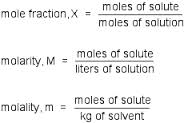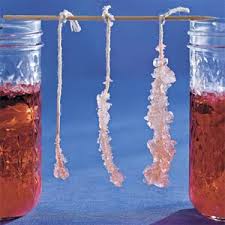Overview
Many common substances exist as solutions, such as the air we breathe, the water that surrounds us, and brass instruments. Solutions are mixtures of two or more substances that are combined so thoroughly that it is difficult to separate the parts.
Definition
Solutions consist of a solute (the substance that is dissolved) and the solvent (the substance that does the dissolving. For example, salt is the solute and water is the solvent in the solution called seawater. Oxygen is dissolved in nitrogen in ordinary air. Carbon dioxide is dissolved in water and flavoring is added to make the solution called soda pop. Gases tend to mix to form solutions, with molecules far apart.
Figure 1: The purple dye (the solute) is dissolved in water (the solvent). As the dye dissolves, the solution changes color.
Solid Solutions
Solid solutions are also called alloys. Gold jewelry is usually not made of pure gold, but a combination of gold and other metals to make it harder, such as copper and silver. Sterling silver is not pure silver, but an alloy of silver and copper. Steel is an alloy of iron and carbon, bronze is an alloy of copper, tin, and zinc, and brass is an alloy of zinc and copper.
Figure 2: These rings are made of different alloys of gold, silver, platinum, and copper to produce the different colors of metal.
Concentrations of Solutions
Solutions can be concentrated, dilute, or somewhere in between. Imagine the difference between the taste of frozen juice concentrate before it is mixed with water and after it is diluted to make a pitcher of juice. While the number of cans of water compared with the frozen can of concentrate is enough direction to make a cool pitcher of juice, it is not a precise enough measurement for chemistry. The concentration can be measured as the amount of solute in a given amount of solvent or solution. It is often measured as molarity, molality, and mole fraction. Molarity is the ratio of the moles of solute to the liters of solution, and it is a measure of volume. Molality is the ratio of moles of solute to kilograms of solvent, and it is a measure of mass. Mole fraction is the ratio of moles of one component of the solution to the total moles of solution.
Figure 3: Three measures of concentration: Molarity, molality, and mole fraction.
Saturation
There is a limit to how much solute can be dissolved in a solvent, and that limit is saturation. It is dependent upon temperature and pressure. Supersaturated solutions are unstable, and are created when more solute is added to a solvent than it can hold. Rock crystals, such as those from salt, sugar, and many other materials, can be created from supersaturated solutions.
Figure 4: Sugar crystals form along a string when a supersaturated sugar solution is left to cool.
Interested in chemistry tutoring services? Learn more about how we are assisting thousands of students each academic year.
SchoolTutoring Academy is the premier educational services company for K-12 and college students. We offer tutoring programs for students in K-12, AP classes, and college. To learn more about how we help parents and students in Harrisburg, PA: visit Tutoring in Harrisburg, PA





